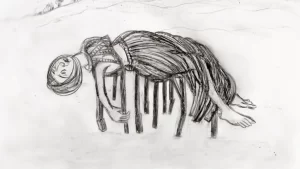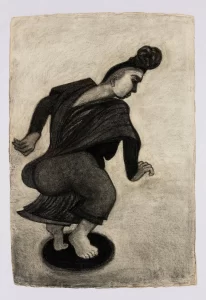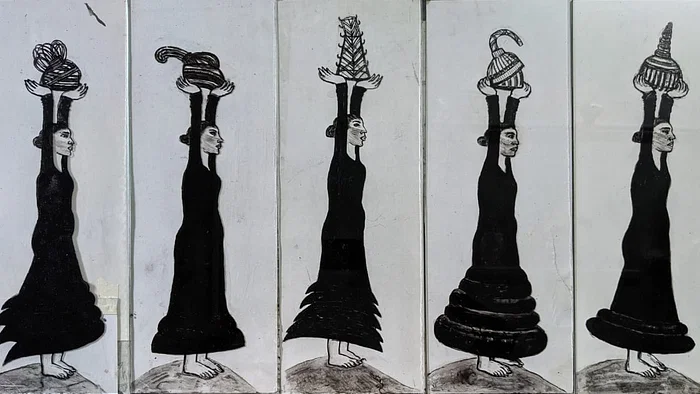Tsuktiben Jamir
More than often, artists are influenced, or rather inspired by the environment around them, their experiences, their understandings, their connections with people and their culture. They condense all of these encounters into their artistic expressions. The artist, the subject as well as the perspectives of perception are all reflected in art. This can be said about Bombay based artist Shakuntala Kulkarni as well. Her latest solo exhibition currently being showcased at Chemould Prescott Road in Mumbai titled ‘Quieter Than Silence: A Compilation Of Short Stories’ is a testimony of this.
These seven series of drawings have been inspired through her observation of the world around her; instances such as the Hathras gang rape and murder case that deeply shook her, the migrant labourers’ hardships during the lockdown that extremely moved her and the one story she came across on a newspaper article about a pregnant lady who was being treated for COVID-19, and who died of excessive bleeding because she was too embarrassed to confide in her family about the harrowing experience she went through of being repeatedly raped by her own doctor. Shakuntala was speechless and enraged upon reading this story.

Courtesy: Mid-day
She uses her art to give a voice to these helpless stories and express her own emotions upon stumbling upon these stories; through her art, she investigates the situation of urban women who are repressed by patriarchy. Art is one of the most important aspects of existence because it is the sole way for the human experience and situation to be shared, compared, and contrasted. A piece of art communicates a visual notion or impression that speech cannot. The ability for people to communicate, translate, and comprehend ideas that reside in the subconscious, those that cannot be articulated simply by explanation, makes art not only significant but also essential.
Shakuntala is a multidisciplinary artist who dabbles in drawing, painting, sculpture and performance. When the nationwide lockdown was declared in 2020, she was unable to meet her cane

Courtesy: Mint Lounge
making crew, which was in Assam. However, she had recently just cleaned up her inventories in the studio for a renovation and came across a number of materials like charcoal sticks, compressed charcoal, handmade paper from Khadi Bhandar, and more. She also discovered extra museum acrylic sheets that were left over from a previous exhibit. She then made the decision to work with the materials on hand and began by painting in reverse using acrylic paint on museum acrylic sheets and glass. She also discovered a roll of handmade paper that she’d bought years earlier. In order to create drawings of ageing women, she began to pin up the sheets. Thus giving birth to the components of her recent exhibition. Meanwhile she also took inspiration from various individuals like Japanese designers Rei Kawakubo and Yohji Yamamoto, Japanese figure skater Yuzuru Hanyu as well as African hairstyles and the artist Frida Kahlo’s hairstyles.
About the title of her exhibition, she aptly said, “I liked the title, and wondered how could anything be more silent than silence itself. When I searched more about it, I found that when you go beyond the noise of the world, there is nothing. And you can create anything out of this emptiness. It’s amazing that an educational organisation that I am associated with also propagates this philosophy. The idea connected and that’s how the title of the show came about.”
Exhibition dates:
9 March – 30 April 2023 (10AM-6PM; Closed on Sundays)





